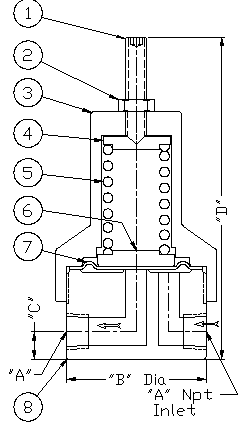This safety relief valve can be used for relieving pressures and maintaining upstream line pressures to a specific set point. Pressure relief valve can also be used for bypassing fluids. This is a diaphragm low-pressure valve which is used where accurate set pressures must be maintained. The large diaphragm area compared to a piston pressure relief valve produces much more accurate pressure control with very low hysteresis between opening and closing pressures. See available orifice sizes and flow Cv below.
See pricing Table to select available options
This is a diaphragm and spring type relief valve where the spring constantly opposes the pressure acting against the diaphragm which seals off the inlet port from the outlet port at the valve seat. The desired relief or bypass pressure is achieved by compressing the spring until the spring force is adequate to balance the pressure force acting against the diaphragm. When the inlet pressure exceeds the set pressure, the diaphragm will open to relieve and bypass the excess pressure.The valve will operate in a vertical orientation as illustrated, horizontal, or any other orientation.
Although the ports are inline, this is not a "through flow" model where flow continuously passes through the valve. If this valve were to be installed in a flow line, it would shut off flow to the line completely and open only when the set pressure is exceeded. This valve is typically mounted to a device to be protected such as a tank or other pressure containing device. If a flow stream needs to be protected from overpressure, then the valve is mounted on the side of a Tee, or at the end of a line branch where it will pass excess flow only when the valve opens. The outlet port of the valve is usually piped to a drain or discharged directly to atmosphere only if the liquid or gas is safe to be discharged without injuring personnel or damaging equipment nearby .




















































































